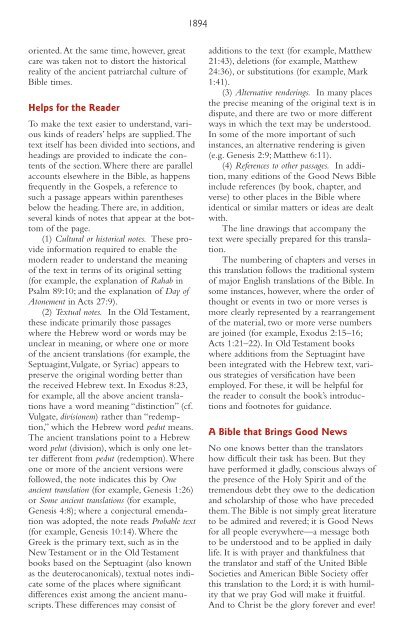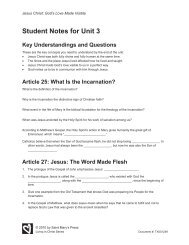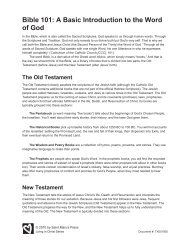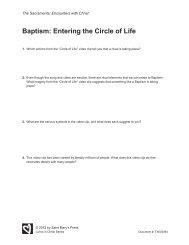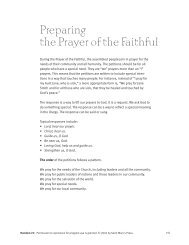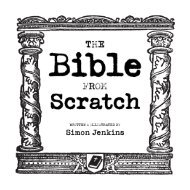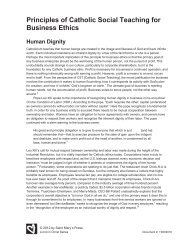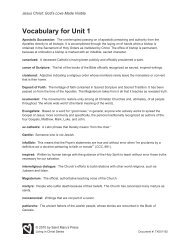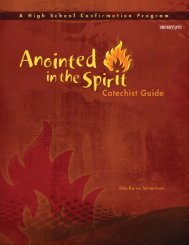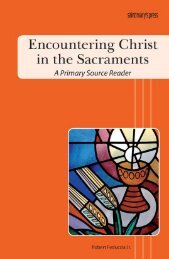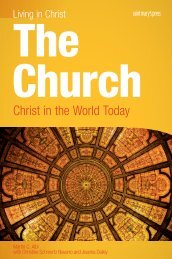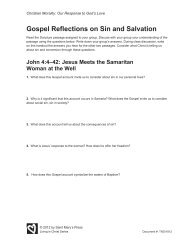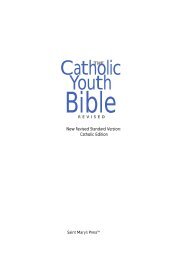New Testament - Saint Mary's Press
New Testament - Saint Mary's Press
New Testament - Saint Mary's Press
You also want an ePaper? Increase the reach of your titles
YUMPU automatically turns print PDFs into web optimized ePapers that Google loves.
1894oriented. At the same time, however, greatcare was taken not to distort the historicalreality of the ancient patriarchal culture ofBible times.Helps for the ReaderTo make the text easier to understand, variouskinds of readers’ helps are supplied.Thetext itself has been divided into sections, andheadings are provided to indicate the contentsof the section.Where there are parallelaccounts elsewhere in the Bible, as happensfrequently in the Gospels, a reference tosuch a passage appears within parenthesesbelow the heading.There are, in addition,several kinds of notes that appear at the bottomof the page.(1) Cultural or historical notes. These provideinformation required to enable themodern reader to understand the meaningof the text in terms of its original setting(for example, the explanation of Rahab inPsalm 89:10; and the explanation of Day ofAtonement in Acts 27:9).(2) Textual notes. In the Old <strong>Testament</strong>,these indicate primarily those passageswhere the Hebrew word or words may beunclear in meaning, or where one or moreof the ancient translations (for example, theSeptuagint,Vulgate, or Syriac) appears topreserve the original wording better thanthe received Hebrew text. In Exodus 8:23,for example, all the above ancient translationshave a word meaning “distinction” (cf.Vulgate, divisionem) rather than “redemption,”which the Hebrew word pedut means.The ancient translations point to a Hebrewword pelut (division), which is only one letterdifferent from pedut (redemption).Whereone or more of the ancient versions werefollowed, the note indicates this by Oneancient translation (for example, Genesis 1:26)or Some ancient translations (for example,Genesis 4:8); where a conjectural emendationwas adopted, the note reads Probable text(for example, Genesis 10:14).Where theGreek is the primary text, such as in the<strong>New</strong> <strong>Testament</strong> or in the Old <strong>Testament</strong>books based on the Septuagint (also knownas the deuterocanonicals), textual notes indicatesome of the places where significantdifferences exist among the ancient manuscripts.Thesedifferences may consist ofadditions to the text (for example, Matthew21:43), deletions (for example, Matthew24:36), or substitutions (for example, Mark1:41).(3) Alternative renderings. In many placesthe precise meaning of the original text is indispute, and there are two or more differentways in which the text may be understood.In some of the more important of suchinstances, an alternative rendering is given(e.g. Genesis 2:9; Matthew 6:11).(4) References to other passages. In addition,many editions of the Good <strong>New</strong>s Bibleinclude references (by book, chapter, andverse) to other places in the Bible whereidentical or similar matters or ideas are dealtwith.The line drawings that accompany thetext were specially prepared for this translation.The numbering of chapters and verses inthis translation follows the traditional systemof major English translations of the Bible. Insome instances, however, where the order ofthought or events in two or more verses ismore clearly represented by a rearrangementof the material, two or more verse numbersare joined (for example, Exodus 2:15–16;Acts 1:21–22). In Old <strong>Testament</strong> bookswhere additions from the Septuagint havebeen integrated with the Hebrew text, variousstrategies of versification have beenemployed. For these, it will be helpful forthe reader to consult the book’s introductionsand footnotes for guidance.A Bible that Brings Good <strong>New</strong>sNo one knows better than the translatorshow difficult their task has been. But theyhave performed it gladly, conscious always ofthe presence of the Holy Spirit and of thetremendous debt they owe to the dedicationand scholarship of those who have precededthem.The Bible is not simply great literatureto be admired and revered; it is Good <strong>New</strong>sfor all people everywhere—a message bothto be understood and to be applied in dailylife. It is with prayer and thankfulness thatthe translator and staff of the United BibleSocieties and American Bible Society offerthis translation to the Lord; it is with humilitythat we pray God will make it fruitful.And to Christ be the glory forever and ever!


